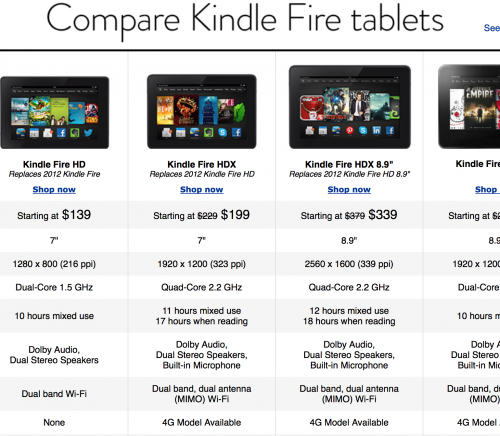Amazon has been a fascinating company to watch. My perspective with Amazon has always framed them as a retailer who fused technology to retail in brilliant ways. Only Amazon’s retail strategy was not in physical space but in the digital space. And their mechanism for commerce was to turn our computers into a cash register. With this backdrop, it is fascinating to analyze Amazon’s Kindle Fire initiatives.
When Amazon jumped into the e-book reader market it made a great deal of sense. Amazon had a differentiated advantage due to their massive investment in gaining digital rights to many of the analog books they were selling. The Kindle readers, tied to the Amazon ecosystem, dominated the e-reader space. During that time nearly every CES (Consumer Electronics Show) I attended grew in the number of fast followers trying to jump on the e-reader bandwagon. None did as well as the Kindle readers and it was simply due to Amazon’s ecosystem. Amazon had a clear differentiated advantage that translated into consumer value with their e-readers. So does that same differentiated advantage apply to their Kindle Fire strategy?
The Kindle Fire has not turned any heads with its sales. While we don’t know for sure how many Kindle Fire sales, the best estimates I’ve seen estimate them to be around 55m to date. Not bad but not incredible compared to the iPads sales over the same time period since the Kindle Fire launched. The issue, as I see it, is that the Kindle Fire does not have the same differentiated advantage that the Kindle e-readers did. With the Fire, Amazon is competing against the likes of the iPad which offers all the same experiences of the Kindle Fire and then some. So why is Amazon in the hardware business?
There are several ways to look at this. My initial belief when Amazon launched the Kindle Fire’s was that Amazon would tightly integrate their commerce experience on the Fire tablets. Thus creating the best shopping experience within Amazon’s ecosystem on the market. This did not happen. The Kindle Fire has been more a media tablet than a commerce tablet for Amazon’s ecosystem.
In fact, interestingly, the Amazon tablet in general is driving less e-commerce spending than other tablets on the market. Data from a 2013 Monetate survey reveals that Amazon Kindle Fire users spend approximately $95 a quarter in digital transactions from the device while the iPad average quarterly spend is approximately $124 dollars. Now we can attribute some of this to the fact that there are way more iPad’s than Kindle Fire’s in the world. But I do think the this is still an important point to watch strategically for Amazon with the Kindle Fire.
Fire in the Enterprise
Amazon has recently added a number of enterprise specific features to the Kindle Fire. This, is actually fascinating and indicative of the types of usages we are observing with Kindle Fires. There is no doubt the Kindle Fire is a great media tablet but the idea that people are wanting to check email and perhaps even review documents is interesting.
We had heard that IT managers were noticing Kindle Fire’s were being brought in by consumers to use to watch video or play games during breaks and lunch. Often times these same customers were interested in checking email during these times as well. This is where we believe the enterprise friendly features Amazon built in were born from.
Without question there are better tablets on the market for doing things like productivity which is why we see iPads and Samsung tablets higher up on the IT managers support list. But it has been interesting to see how this has developed for Amazon.
The Hardware Strategy
With regard to the Kindle Fire, I have concluded that this business is important to Amazon but not essential. Like all of Amazon’s investments in businesses there is a long term goal. The Kindle Fire right now is playing more of a data gathering tool than anything else for Amazon. They are learning how tablet customers and more specifically Amazon customers using tablets are doing with regard to e-commerce, media consumption, and app usage / web browsing.
In fact, if the tablet market is hitting a slow down period then this will impact Amazon quite a bit given their strategy. It is likely that as of now, Amazon is stuck in the middle from a hardware standpoint.
This will have benefits in the long term as Amazon can continue to customize their offerings uniquely for their customers. Amazon exhibits a similarly valuable trait to Apple that continually gets mis-understood by investors and main stream media — patience.

I thought sales of the Kindle Fire were almost an order of magnitude lower than your estimate. Where do your numbers come from?
Range of sources. Estimates of my own through supply chain / SoC tracking as well as what IDC and Gartner have estimated. The number is saw prior to Q4 was nearly 50 m and estimates were they did just over 5 in Q4.
Again no idea how much is sell through vs. Sell in.
Thanks! The last number I saw was Dediu’s estimate of 5 million for the original Kindle Fire. I didn’t realize it was doing that much better.
That was way back when Horace did that. The launch quarter for the Fire was 5m. And they have typically held steady at or around 5m per qtr except in the holiday quarters where they did double digits. So that number is again fires to date since launch. It hasn’t been a failure but again comparatively its low. And hitting a wall apparently.